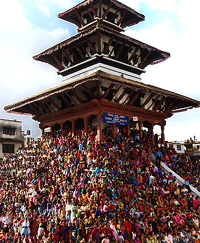 Not only does Nepal have many gods, goddess, deities, Bodhisattvas (near Buddhas), avatars and manifestations, which are worshipped and revered as statues, images, paintings and symbols, but it also has a real living goddess. The Kumari Devi is a young girl who lives in the building known as the Kumari Ghar, right beside Kathmandu's Durbar Square.
Not only does Nepal have many gods, goddess, deities, Bodhisattvas (near Buddhas), avatars and manifestations, which are worshipped and revered as statues, images, paintings and symbols, but it also has a real living goddess. The Kumari Devi is a young girl who lives in the building known as the Kumari Ghar, right beside Kathmandu's Durbar Square. From time immemorial the practice of worshipping an ordinary pre-pubescent girl as a source of supreme power has been an integral
part of both Hinduism and Buddhism, a tradition which continues even to this day virtually in every household. They call this girl Kumari Devi and worship her on all the religious occasions.
The predominance of the Kumari cult is more distinctly evident among the Newar community inside the Kathmandu Valley as she has become an inevitable feature of their worship almost in every Vihar and Bahal and including the nooks and corners of Newari settlements. However, it was the Vajrayana sect of Mahayana Buddhism that was responsible for establishing the tradition of worshipping a girl from the Sakya community as the royal Living Goddess.
The selection of the Living Goddess is a highly elaborate tantric ritual. Upon passing the preliminary test, this is merely concerned with their 32 attributes of perfection, including the colour of her eyes, the shape of her teeth and the sound of her voice. Her horoscope must also be appropriate. The 4 to 7 year poor girls from the Sakya community are made to confront a goddess in the darkened room. The sight of the Buffalo heads scattered around, the demon- like masked dancers, the terrifying noises theyencounter scare some of these innocent babies. The real goddess is unlikely to be frightened, so the one who is calm and collected throughout the tests is the only girl who is entitled to sit on the pedestal for worship as the Living Goddess. Then as a final test similar to that of the Dalai Lama, the Kumari then chooses items of clothing and decoration worn by her predecessor.
The god-house Kumari Ghar is a store-house of magnificent intricate carvings where the Living Goddess performs her daily rituals. During her tenure in the god-house, Guthi Sansthan, the government trust fund bears her entire expenses including that of her caretakers. Under normal circumstances, her days in the god-house come to an end with her first menstruation, but if she turns out to be unlucky, as they say, even a minor scratch on her body that bleeds can make her invalid for worship. She then changes back to the status of normal mortal and the search of a new Kumari begins. It is said to be unlucky to marry an ex-Kumari.
 On Indra Jatra, in September, the Living Goddess in all her jeweled splendor travels through the older part of Kathmandu city in a three tiered chariot accompanied by Ganesh and Bhairab each day for three days. It is really a grand gala in which people in their thousands throng in and around the Kathmandu Durbar Square to pay their homage to the Living Goddess. During this festival she also blesses the King in keeping with the tradition in which the first king of the Shah dynasty, who annexed Kathmandu in 1768, received a blessing from the Living Goddess.
On Indra Jatra, in September, the Living Goddess in all her jeweled splendor travels through the older part of Kathmandu city in a three tiered chariot accompanied by Ganesh and Bhairab each day for three days. It is really a grand gala in which people in their thousands throng in and around the Kathmandu Durbar Square to pay their homage to the Living Goddess. During this festival she also blesses the King in keeping with the tradition in which the first king of the Shah dynasty, who annexed Kathmandu in 1768, received a blessing from the Living Goddess.







 On Indra Jatra, in September, the Living Goddess in all her jeweled splendor travels through the older part of Kathmandu city in a three tiered chariot accompanied by Ganesh and Bhairab each day for three days. It is really a grand gala in which people in their thousands throng in and around the Kathmandu Durbar Square to pay their homage to the Living Goddess. During this festival she also blesses the King in keeping with the tradition in which the first king of the Shah dynasty, who annexed Kathmandu in 1768, received a blessing from the Living Goddess.
On Indra Jatra, in September, the Living Goddess in all her jeweled splendor travels through the older part of Kathmandu city in a three tiered chariot accompanied by Ganesh and Bhairab each day for three days. It is really a grand gala in which people in their thousands throng in and around the Kathmandu Durbar Square to pay their homage to the Living Goddess. During this festival she also blesses the King in keeping with the tradition in which the first king of the Shah dynasty, who annexed Kathmandu in 1768, received a blessing from the Living Goddess.











